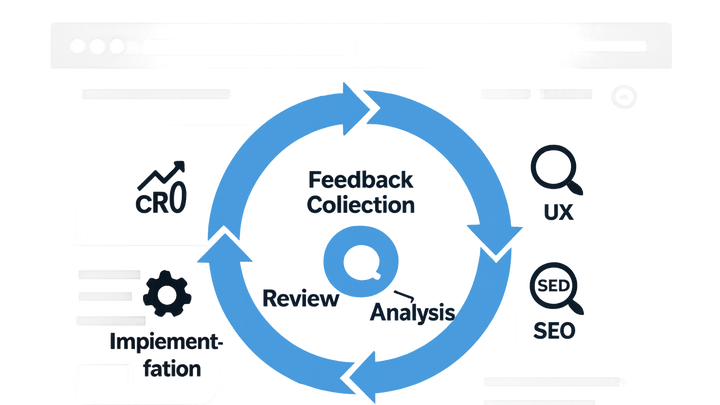Published on 2025-06-29T21:39:26Z
What is a Customer Feedback Loop? Examples for Website CRO, UX & SEO
Customer Feedback Loop is an iterative process for website optimization in the fields of CRO, UX, and SEO. It involves:
- Collecting feedback from users via surveys, on-page widgets, and session recordings.
- Analyzing insights to identify pain points, trend patterns, and content gaps.
- Implementing changes to design, content, and functionality.
- Reviewing results and restarting the cycle for continuous improvement.
Platforms like Prevue.me streamline this loop by providing actionable critiques and prioritized recommendations for maximum lead generation, UX enhancements, and SEO gains.
Customer feedback loop
A cyclical process of gathering, analyzing, and acting on user feedback to optimize website conversion rates, UX, and SEO.
Why Customer Feedback Loops Matter in CRO/UX/SEO
This section explores how continuous user feedback influences conversion rates, user satisfaction, and search rankings. It highlights why structured feedback loops outperform one-off surveys.
-
Driving conversion rate optimization (cro)
Continuous feedback uncovers barriers in the buying process, enabling you to refine CTAs, forms, and page layouts to boost conversions.
- Identify conversion barriers:
Use feedback to pinpoint exact steps where users drop off or express confusion.
- Hypothesis testing:
Develop and test targeted experiments based on user insights to validate improvements.
- Identify conversion barriers:
-
Enhancing user experience (ux)
Real user critiques guide design tweaks, navigation restructuring, and content clarity to elevate satisfaction and engagement.
- Uncover usability issues:
Feedback highlights frustrating interactions, poor readability, or confusing flows.
- Prioritize high-impact changes:
Allocate effort to updates that users consistently request or complain about.
- Uncover usability issues:
-
Improving seo performance
User-centric content and streamlined site architecture informed by feedback can lower bounce rates and signal quality to search engines.
- Optimize content relevance:
Adjust copy and keywords based on users’ search intent and clarity feedback.
- Enhance site structure:
Rework navigation and internal linking to reflect how users look for information.
- Optimize content relevance:
Key Components of a Customer Feedback Loop
Breaking down the feedback loop into its core stages ensures a systematic approach to collecting, analyzing, and acting on user input.
-
Feedback collection
Gather user opinions using surveys, on-page widgets, session recordings, and rating systems.
- On-page feedback widgets:
Embedded tools like prevue.me let users comment on specific elements for context-rich insights.
- Customer surveys:
Short, targeted surveys capture NPS or satisfaction scores at key journey stages.
- On-page feedback widgets:
-
Analysis and interpretation
Transform raw feedback into actionable insights through categorization, sentiment analysis, and quantitative metrics.
- Sentiment tagging:
Mark comments as positive, negative, or neutral to prioritize issues.
- Trend identification:
Group similar feedback to detect recurring pain points or feature requests.
- Sentiment tagging:
-
Action and implementation
Translate insights into design changes, content updates, or functional enhancements, then deploy them.
- Prioritization framework:
Use impact-vs-effort matrices to decide which changes to implement first.
- A/b testing:
Test hypotheses derived from feedback to measure real-world impact.
- Prioritization framework:
-
Review and iteration
After implementation, evaluate results through analytics and fresh feedback, repeating the cycle for ongoing optimization.
- Performance tracking:
Monitor conversion metrics and user behavior post-change.
- Continuous improvement:
Re-engage users for feedback on changes and refine further.
- Performance tracking:
Implementing a Feedback Loop with Prevue.me
prevue.me simplifies capturing actionable critiques by allowing users to comment directly on your pages and providing prioritized insights for CRO, UX, and SEO improvements.
-
Setup and onboarding
Install the prevue.me widget on key pages like landing pages, checkout funnels, and content hubs.
- Customize feedback prompts:
Tailor questions to focus on lead-gen forms, navigation ease, and content relevance.
- Define target audiences:
Select user segments for feedback collection to get context-specific insights.
- Customize feedback prompts:
-
Collecting feedback
Invite visitors to leave critiques at touchpoints and use automated triggers to prompt input.
- Passive prompts:
Display unobtrusive feedback requests after a set time or scroll depth.
- Active invitations:
Reach out via email follow-ups or in-app messages for targeted feedback.
- Passive prompts:
-
Prioritizing and sharing insights
Use prevue.me’s prioritization engine to rank feedback by potential impact on leads and conversions.
- Impact score:
Review scores that predict which critiques will yield the biggest lift.
- Team collaboration:
Share feedback reports with stakeholders to align on action plans.
- Impact score:
-
Iteration and monitoring
Implement recommended changes, track performance in analytics, and re-launch feedback cycles.
- A/b test changes:
Validate which adjustments drive the most improvement.
- Monitor seo metrics:
Watch SERP rankings and organic traffic for content-related updates.
- A/b test changes:
Best Practices and Common Pitfalls
Maximize the value of your feedback loops by following proven strategies and steering clear of typical mistakes.
-
Maintain continuous engagement
Keep feedback channels open and regularly solicit insights rather than relying on one-time surveys.
- Feedback cadence:
Schedule periodic feedback drives aligned with major site changes.
- User incentives:
Offer small rewards or recognition to encourage participation.
- Feedback cadence:
-
Avoid analysis paralysis
Focus on high-impact trends rather than every single comment to prevent being overwhelmed.
- Filter for influence:
Prioritize feedback that aligns with business goals and user journeys.
- Set clear goals:
Define what success looks like before analyzing feedback.
- Filter for influence:
-
Follow through on feedback
Ensure changes based on user input are actually implemented; communicate updates to users to close the loop.
- Action logs:
Maintain a record of feedback items and their resolutions.
- User communication:
Notify participants when their suggestions have been addressed to build trust.
- Action logs:
